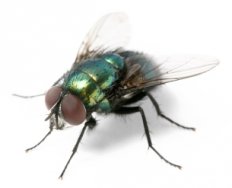Flies
 The Drain flies are the most commonly encountered fly or gnat in commercial establishments. They are approximately 1/10” long, and have long hairs on their wings and bodies, giving them a fuzzy appearance. Wings are held roof-like over the body when the fly is at rest.
The Drain flies are the most commonly encountered fly or gnat in commercial establishments. They are approximately 1/10” long, and have long hairs on their wings and bodies, giving them a fuzzy appearance. Wings are held roof-like over the body when the fly is at rest.
Normally the time required to complete the life cycle is 2 - 3 weeks. The eggs are deposited near the surface of organic materials such as around drains, bathtub drains, sewage plants and water traps in plumbing fixtures.
Adults are not strong fliers and can be observed most of the time running or walking on walls. However, they can be carried by wind currents.
As with most flies, the key to obtaining control of drain flies is to eliminate the breeding source. Areas where there are accumulations of organic debris or fermenting foods must be cleaned thoroughly.
The following steps should be implemented in order to obtain control of these flies. These sanitation procedures are the key, as with most fly control programs, to creating a pro-active drain fly control program.
1) Garbage Handling: Whenever possible, garbage dumpsters should be located away from the structure. These areas should be cleaned regularly to remove food debris accumulations around the compactor and dumpster pads. Trash and garbage receptacles used within the building should be emptied daily and cleaned with detergent and water at least twice a week. Keep all trash chutes free of food debris on a regular basis and make sure all residues are removed.
2) Drain Cleaning Procedures: Organic debris can accumulate in floor drains. Drain flies may be found in the slime layers around the lips of the drains. Establish a routine program using Bioremediation techniques for cleaning drains and floor junctures. The bioremediation solution KB-4F is designed to digest the fats, oils, grease, starches and sugars which are the cause of organic buildup in drain lines, and turn them into water. KB-4F will control the odors associated with built up organic material as well.
3) Mop & Broom Handling: Mops and brooms can retain food particles inn them. All mops and brooms heads should be cleaned thoroughly before returning them to the storage location. In order to allow mops and brooms to dry thoroughly they should be mounted on a wall rack system.
4) Exclusion: During warm weather it is very important to keep doors closed when they are not in use. Place fine meshed screens on windows which are left open for ventilation purposes. Always consider installing air door screens on doors which open for long periods of time.
5) Contact your Gotcha! Pest Control Specialist for more information on which control methods are best for your establishment.
Fruit Flies
Fruit flies are the most commonly encountered small fly or gnat found in homes and one of the most common in commercial establishments. Fruit flies are approximately 1/8” long, have bright red eyes, and their body is tan in color. The abdomen may appear dark or black striped.
The female fruit fly will lay approximately 500 eggs in her lifetime. These eggs are deposited near the surface of fermenting materials such as fruit, dirty trash containers, decaying organic matter which is trapped under kitchen equipment or in the slime found in drains. Other areas where they may breed include, but are not limited to: refrigerator and air conditioner condensation pans, dirty mops and brooms and the accumulation of organic debris underneath floor tiles. Under ideal environmental conditions the fruit fly can go from egg to adult stage in eight to nine days.
The adult fruit flies are strong fliers and may appear in areas which are far from their breeding source, sometimes hundreds of feet. During warm weather, they may enter and invade structures from the outdoors.
As with most fly control programs, the key to control are to eliminate the breeding source. Areas where there are accumulations of organic debris or fermenting foods must be cleaned.
The following steps should be implemented in order to obtain control of these flies. These sanitation procedures are the key, as with most fly control programs, to creating a pro-active fruit fly control program.
1) Garbage Handling: Whenever possible, garbage dumpsters should be located away from the structure. These areas should be cleaned regularly to remove food debris accumulations around the compactor and dumpster pads. Trash and garbage receptacles used within the building should be emptied daily and cleaned with detergent and water at least twice a week. Keep all trash chutes free of food debris on a regular basis and make sure all residues are removed.
2) Drain Cleaning Procedures: Organic debris can accumulate in floor drains. Fruit flies may be found in the slime layers around the lips of the drains. Establish a routine program for cleaning drains and drain/floor junctures.
3) Mop & Broom Handling: Mops and brooms can retain food particles inn them. All mops and brooms heads should be cleaned thoroughly before returning them to the storage location. In order to allow mops and brooms to dry thoroughly they should be mounted on a wall rack system.
4) Equipment Cleaning: Floors underneath equipment must be thoroughly cleaned. Any cracks in tiles and floor grouting should be sealed promptly. Clean inside equipment as well. Equipment such as juice machines and garbage disposals may have spills inside them. The interior of this equipment must be thoroughly cleaned.
5) Recycling Procedures: Do not let aluminum cans or bottles with pop syrup or other food residues sit in recycling bins for long periods of time. These containers may serve as sources for fruit fly infestations. Clean these containers on a regular basis. Empty at least twice a week or more.
6) Exclusion: During warm weather it is very important to keep doors closed when they are not in use. Place fine meshed screens on windows which are left open for ventilation purposes. Always consider installing air door screens on doors which open for long periods of time.
7) Additional Control Procedures: Jar traps, light traps and glue traps with vinegar can be useful in capturing fruit flies. Pyrethrin based space sprays may also be used when food and food contact surfaces are not exposed. Contact your Gotcha! Pest Control Specialist for more information on which control methods are best for your establishment.
House Flies
House flies are the most common fly found in homes, restaurants and other structures. Adult house flies can lay their eggs in manure, garbage or decaying meat. The can readily breed in fresh and wet incinerated garbage but not in scattered, dry garbage. It is possible to have as many as 800 - 900 fly pupas developing from one ounce of manure.
The house fly passes through four stages in its life cycle: egg, larva or maggot, pupa and adult. The entire life cycle can be completed in 7 - 10 days under ideal environmental conditions. Adult females can lay as many as 2,700 eggs in 30 days but on average this number is much smaller 300 - 900 in 5 or 6 different batches. The eggs, which are laid singly, but often appear in clusters, hatch in 6 to 24 hours. The maggot remains in the breeding media for 4 - 10 days, feeding and growing. In wet breeding areas, the full grown larvae climb to the surface or sides of the breeding media before pupating. In some cases the larva have crawled a considerable distance from the breeding source in order to pupate. The Pupal stage lasts for 3 - 6 days. The adult female is ready to lay eggs in 20 - 22 days after emerging and continues to lay eggs for about one month. Adult flies live 30 - 60 days on average in warm months. In colder Northern areas, some adults may survive indoors for several months.
Eggs: House fly eggs are white, elongate and about 1/20” long.
Larva: The larva is also referred to as a maggot. When it emerges from the egg it is transparent in color. As it grows it takes on a creamy white color. Maggots have no legs and are somewhat carrot shaped. The maggot has two small openings used for breathing which are located at the hind end. They are about 2/5” long.
Pupa: The pupa is reddish-brown in color. They are barrel-shaped and about 3/8” long. Pupal cases are sometimes mistaken for American cockroach egg capsules.
Adults: The adult house fly has two wings (most adult insects have four). There are four narrow black stripes located on the thorax. The adult house fly is ¼” long.
Houseflies are a danger to the health of man and animals for the simple reason that they carry and spread disease organisms. They move from garbage and sewage to dinner plates and foodstuffs. They carry bacteria on the outside of their bodies then regurgitate saliva and deposits wastes on human food. In this comparison the cockroach is a sanitary insect.
Houseflies usually stay near their breeding sources yet it is possible they can travel many miles when carried by wind currents. Houseflies prefer to rest on corners and edges of thin objects. At night they usually rest near their food source, 5 - 15 feet off the ground.
Sanitation & Control of Houseflies
Due to the fact that houseflies breed so rapidly, sanitation and the elimination of breeding areas needs to be considered. If breeding conditions are ideal, no amount of chemical will successfully control the population. Below we have listed some breeding areas and what you can do about them.
1) Garbage cans and dumpsters: Garbage should be picked up two to three times a week. Garbage cans should be kept clean inside. Dumpsters and compactors should be on cement pads and kept as far away from doors as possible. The areas should be cleaned regularly. Cold water washes with high pressures (700 lbs. psi) will kill fly maggots. Always keep lids on trash cans.
2) Inside food handling establishments: Clean grease and spilled food from behind equipment, etc.
3) Screen doors: Screens can be very effective in keeping flies out. Remember, although, that screens must be kept closed to work.
4) Air doors: Not as effective as screens but still effective is the air door. Air doors must be installed properly so there are no blank areas in the air curtain and the velocity must be 1,600 ft. /min. or more. Air doors must be checked periodically to make sure they are working properly.
5) Insect light traps (ILT): These are very effective tools to use once flies have entered the facility. By positioning the light so you don’t attract the flies from the outside, these devices are extremely effective for several types of fly control.
6) Temperatures: Temperatures can be used to slow down fly activity. Adult egg laying activity ceases at 50 degrees F.
